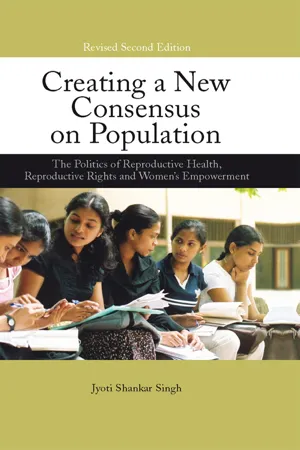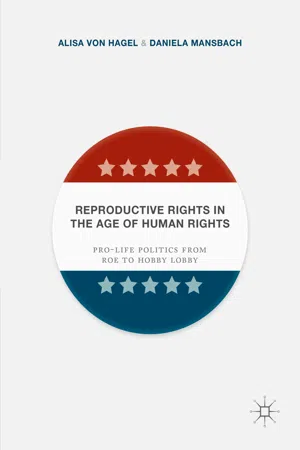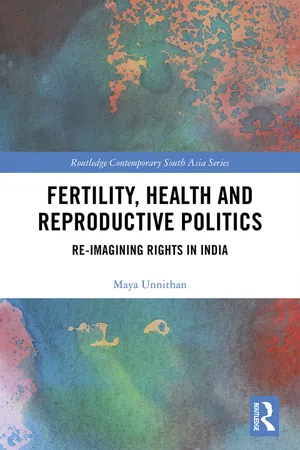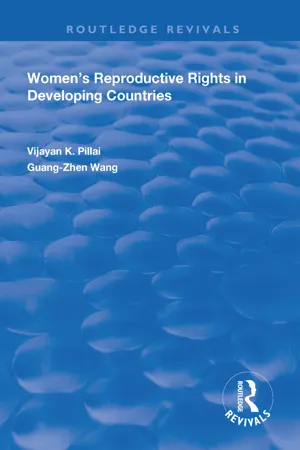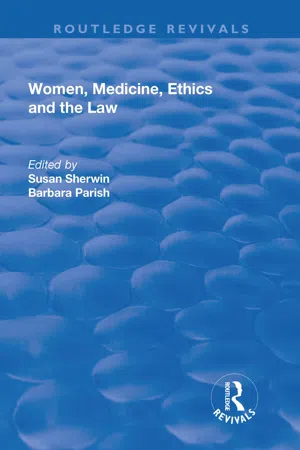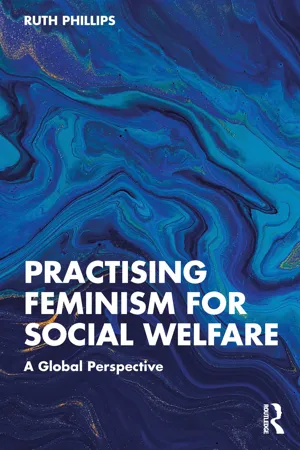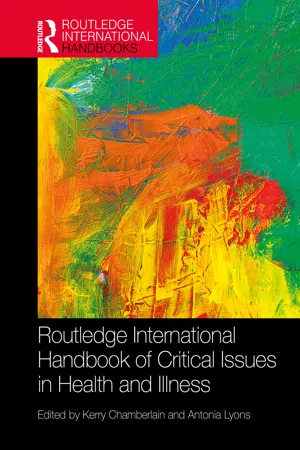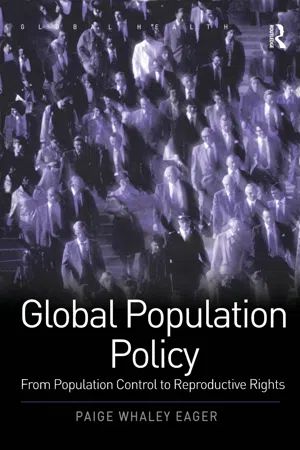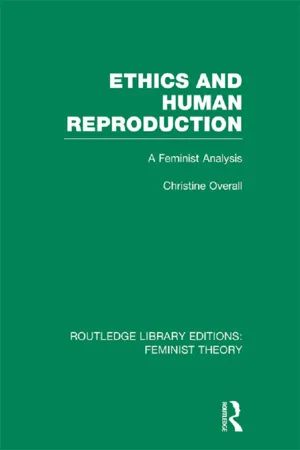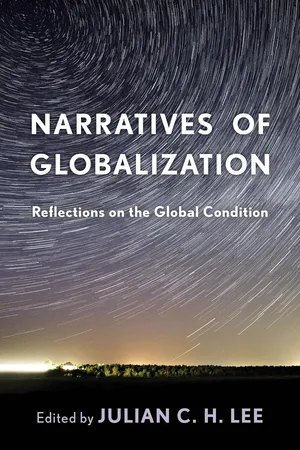Politics & International Relations
Reproductive Rights
Reproductive rights refer to the legal rights and freedoms of individuals to make decisions about their reproductive health and well-being. This includes the right to access contraception, abortion, and reproductive healthcare services, as well as the right to make decisions about when and whether to have children. Reproductive rights are often a topic of debate and advocacy in discussions about gender equality and public health.
Written by Perlego with AI-assistance
Related key terms
12 Key excerpts on "Reproductive Rights"
- eBook - ePub
Creating a New Consensus on Population
The Politics of Reproductive Health, Reproductive Rights, and Women's Empowerment
- Jyoti Shankar Singh(Author)
- 2013(Publication Date)
- Routledge(Publisher)
7.2. Reproductive health is a state of complete physical, mental and social well-being and not merely the absence of disease or infirmity, in all matters relating to the reproductive system and to its functions and processes. Reproductive health therefore implies that people are able to have a satisfying and safe sex life and that they have the capability to reproduce and the freedom to decide if, when and how often to do so. Implicit in this last condition are the right of men and women to be informed and to have access to safe, effective, affordable and acceptable methods of family planning of their choice, as well as other methods of their choice for regulation of fertility which are not against the law, and the right of access to appropriate health-care services that will enable women to go safely through pregnancy and childbirth and provide couples with the best chance of having a healthy infant. In line with the above definition of reproductive health, reproductive health care is defined as the constellation of methods, techniques and services that contribute to reproductive health and well-being by preventing and solving reproductive health problems. It also includes sexual health, the purpose of which is the enhancement of life and personal relations, and not merely counselling and care related to reproduction and sexually transmitted diseases.7.3. Bearing in mind the above definition, Reproductive Rights embrace certain human rights that are already recognized in national laws, international human rights documents and other consensus documents. These rights rest on the recognition of the basic right of all couples and individuals to decide freely and responsibly the number, spacing and timing of their children and to have the information and means to do so, and the right to attain the highest standard of sexual and reproductive health. It also includes their right to make decisions concerning reproduction free of discrimination, coercion and violence, as expressed in human rights documents. In the exercise of this right, they should take into account the needs of their living and future children and their responsibilities towards the community. The promotion of the responsible exercise of these rights for all people should be the fundamental basis for government- and community-supported policies and programmes in the area of reproductive health, including family planning. As part of their commitment, full attention should be given to the promotion of mutually respectful and equitable gender relations and particularly to meeting the educational and service needs of adolescents to enable them to deal in a positive and responsible way with their sexuality. Reproductive health eludes many of the world’s people because of such factors as: inadequate levels of knowledge about human sexuality and inappropriate or poor-quality reproductive health information and services; the prevalence of high-risk sexual behaviour; discriminatory social practices; negative attitudes towards women and girls; and the limited power many women and girls have over their sexual and reproductive lives. Adolescents are particularly vulnerable because of their lack of information and access to relevant services in most countries. Older women and men have distinct reproductive and sexual health issues which are often inadequately addressed - eBook - ePub
Local Action/Global Change
A Handbook on Women's Human Rights
- Julie A. Mertus, Nancy Flowers(Authors)
- 2015(Publication Date)
- Routledge(Publisher)
6 Women's Human Rights to Reproduction and Sexuality DOI: 10.4324/9781315633619-6[R]eproductive rights embrace certain human rights that are already recognized in national laws, international human rights documents and other consensus documents. These rights rest on the recognition of the basic right of all couples and individuals to decide freely and responsibly the number, spacing and timing of their children and to have the information and means to do so, and the right to attain the highest standard of sexual and reproductive health.—Programme of Action, United Nations International Conference on Population and Development, Paragraph 7.3We, the Governments participating in the Fourth World Conference on Women, are determined to … [e]nsure equal access to and equal treatment of women and men in education and health care and enhance women’s sexual and reproductive health as well as education.—Beijing Platform for Action, Paragraph 1.30Objectives
The learning activities and background information contained in this chapter will enable participants to work toward the following objectives:- Recognize the importance of reproductive and sexual rights for women and their interconnection with other human rights.
- Identify obstacles to women’s reproductive and sexual rights.
- Define the role of government, community leaders, the media, and women themselves in protecting and advocating for women’s reproductive and sexual rights.
- Critically analyze the relation between population policies and reproductive and sexual rights.
- Debate the issue of reproductive and sexual health education from the perspective of women’s human rights.
- Remember core concepts.
Getting Started: Thinking About Reproductive and Sexual Rights
About half the world’s female population is of reproductive age (15–49). Over the next twenty years, this group will increase by 30 percent. Half of the world’s population is under the age of 25, and within fifteen years—less than one generation—all 3 billion will have reached reproductive age.1 - eBook - ePub
Reproductive Rights in the Age of Human Rights
Pro-life Politics from Roe to Hobby Lobby
- Alisa Von Hagel, Daniela Mansbach(Authors)
- 2016(Publication Date)
- Palgrave Macmillan(Publisher)
2000 ).Reproductive Rights
The term “Reproductive Rights” encompasses a broad range of issues involving reproduction and reproductive health. In the USA, the discussion of rights generally includes the choice to have or not have children, the timing and spacing of childbirth, and the freedom to make these decisions without coercion or threats of violence (Rubin 1994 ). The primary issues at stake in the discussion of Reproductive Rights include the right to birth control, abortion, sterilization, and, more recently, the right to obtain fertility treatments. Controversy over the right to birth control, abortion, and sterilization is not new, and the current debates over these issues reflect many of the same themes regarding the right to life, the rights of individuals, and freedom from coercion (Engelman 2011 ).The birth control movement of the early 1900s was a culmination of broader social and political changes taking place in the USA at the turn of the century. Increased immigration, the tremendous growth of manufacturing cities on the East Coast, and the absence of social welfare or safety net led to the development of this movement, encouraging smaller families and preventing self-induced abortions. Despite the broader social changes under way in the USA, and the growing acceptance of birth control among some quarters of the population, birth control was illegal under the Comstock Act of 1873. A product of Victorian-era ideals, the Comstock Act promoted purity, self-restraint, and traditional gender norms, criminalizing pornography, erotica, as well as birth control and abortion (Rubin 1994 ). The birth control movement aimed at ensuring that women were educated and aware of issues surrounding reproductive health and the options available to them. As such, this movement represented one of the first large-scale efforts to promote women’s autonomy and choice in the spacing and timing of childbirth (Engelman 2011 - eBook - ePub
Fertility, Health and Reproductive Politics
Re-imagining Rights in India
- Maya Unnithan(Author)
- 2019(Publication Date)
- Routledge(Publisher)
8 Re-imagining rights and the quest for reproductive justice Rights (adhikar) have arrived but justice (nyaya) has not followed. (Fieldwork respondent, Jaipur 2010) In this book I have developed the notion of reproductive politics as being about gendered struggles over the reproductive body as a physical, social and discursive entity. I suggest that as a concept reproductive politics provides an analytic lens to understand the diffusion of global norms such as Reproductive Rights – how they circulate, get rooted and what they come to mean for the poor in their relation to the state and for how development is practised by state, professional and civil society actors. A key concern has been to analyse the implications that sexual reproductive health rights discourse has for development practice and equally for longer established indigenous reproductive claims-making processes. As a politically informed process based on both discourse and lived experience, the focus on fertility and reproduction in this book goes beyond an apolitical rendering of these topics within demographic and population literature (Zaidi and Morgan, 2017). In so doing I have attempted to provide critical insight into the ways in which citizenship is made meaningful in everyday contexts where social reproduction is negotiated at the intersection of family, community, and state and civil society interests and concerns. In this concluding chapter of the book 1 I reflect on the overall complex meanings and interdependencies between sexual, reproductive and health rights that have emerged in the findings of the fieldwork. I draw on recent (predominantly feminist) scholarship on justice, including the moral basis of justice (Sen, 2009), to suggest new ways of imagining rights which capture on the ground complexities in an inclusive frame of reproductive justice - Vijayan K Pillai, Guang-Shen Wang(Authors)
- 2018(Publication Date)
- Routledge(Publisher)
6 Explanations of Reproductive RightsIt was indicated that Reproductive Rights in developing countries have three broad sources. The first source is the population control movement with its sometimes coercive tendencies and the undesirable health outcomes of modern contraceptive technology among women in developing countries. Very often, coercive methods of birth control are combined with the exploitation of women for contraceptive research. The political backlash spearheaded by women's organizations against the violation of women's bodies provided sustenance to the Reproductive Rights movement. Secondly, in recent times, the growth of women's health programs has emphasized the importance of Reproductive Rights as a precondition for improvements in women's health globally. A third source is the long-term evolution of human rights values during the last three centuries. Changes in values and political reactions against overzealous birth control delivery systems bring about changes in the social institutions related to reproduction. These three broad sources are associated with social structural factors. The levels of Reproductive Rights in developing countries may be accounted for by social structural factors.Current sociological research on Reproductive Rights has several drawbacks. First, sociologists have not adequately developed theoretical models of rights (Turner, 1993). Classical works of Durkheim (1893, 1895, 1897, 1912), Weber (1921), and Veblen (1914, 1921) clearly pointed to the role of rights in modern societies. They argue that preservation of rights is essential for achieving integrity and solidarity in society and allude to a structural basis for the emergence of norms. Weber (1921) suggests that economic development, more specifically capitalistic development is a factor in the development of legal norms. Unlike Marx, Weber sees economy as the primary force influencing law. He placed the effects of economy on law alongside those of political and social factors and policies. However, these theoretical insinuations have not been adequately utilized for formulating sociological models of Reproductive Rights.- eBook - ePub
- Susan Sherwin, Barbara Parish(Authors)
- 2018(Publication Date)
- Routledge(Publisher)
27 States parties assume obligations to determine risks to women’s reproductive health. The means chosen by states parties to address dangers to reproductive health are to be determined by national considerations, such as patterns of reproductive health-service delivery and the epidemiology of reproductive disability. The goal is the reduction of maternal mortality and morbidity and enhancement of the dignity of women and their reproductive self-determination.If international human rights law is to be truly universal, it has to require states to take effective preventive and curative measures to protect women’s reproductive health and to afford women the capacity for reproductive self-determination. International human rights treaties require international and national law to secure women’s rights to: (1) freedom from all forms of discrimination; (2) liberty and security, marriage and the foundation of families, private and family life, and information and education; and (3) access to health care and the benefits of scientific progress.28Treaty Interpretation
Empirical evidence and feminist legal methods can be used to reveal the law’s neglect of women’s reproductive health and expose legal bias that damages women. Empirical surveys and epidemiological studies, including those developed by the United Nations (UN) and its specialized agencies,29 demonstrate how governmental neglect of reproductive health results in high levels of avoidable maternal and infant death and sickness, and in the exclusion of women from educational, economic, and social opportunities.Empirical data show inequities in access to reproductive health services. Governments need to weigh evidence of how laws endanger the rights of women. Data are widely available showing that maternal and infant mortality and morbidity are associated with a dearth of family planning services.30 - eBook - ePub
Practising Feminism for Social Welfare
A Global Perspective
- Ruth Phillips(Author)
- 2022(Publication Date)
- Routledge(Publisher)
Jacobs and Stevens, 2019 ). Pro-life, conservative women and men, bolstered by their religious faith and righteousness, have reasserted an idea of womanhood as motherhood that is secondary to an unborn child. From this perspective, pregnant women are seen as vessels for producing a child, regardless of how a pregnancy occurred or their potential or capacity for being a parent. The wave of regressive changes in Reproductive Rights has met with strong feminist activism, in the form of public protests and legal action, but with the rise of authoritarian, populist governments across the world these rights are being systematically withdrawn in several countries. Rights to determine one’s own reproductive experiences is also an area that has a sharp divide between global North and global South experiences, especially in relation to the nature of differing welfare states and the level of under-resourcing for women’s health. Given the now historical success of women’s movements in the global North in achieving recognition of specific reproductive needs, such as access to contraception, abortion, maternal health services and assisted reproduction, it is difficult to comprehend the extent to which the battles to gain such rights will have to be fought for again in some countries. For feminist practice in the field of Reproductive Rights, success lies in achieving widespread support in communities and across nations and continuing to assert the persistently troubling demand for gender equality.References
- ABC (Australian Broadcasting Corporation) (2019) Anti-abortion activists lose High Court challenge to laws banning protests outside clinics. ABC News , April 10, 2019. https://www.abc.net.au/news/2019-04-10/anti-abortion-protestors-lose-high-court-bid/10987714 .
- Alzate , M.M. (2009) The role of sexual and Reproductive Rights in social work practice. Affilia , 24 (2), 108–119.
- arora , N. (2017) Menstruation in India: Ideology, politics, and capitalism. Asian Journal of Women’s Studies
- Kerry Chamberlain, Antonia Lyons(Authors)
- 2021(Publication Date)
- Routledge(Publisher)
There is undoubtedly scope for work on sexual and gender diversity within the reproductive justice movement and framework, with reproductive justice described as “a natural home” (Nixon, 2013, p. 79) for such efforts. Certainly, lesbian, gay, bisexual, transgender, and queer persons have been a part of reproductive justice and sexual liberation movements for as long as these have existed (Flores et al., 2011). It has only been more recently, however, that queer and reproductive justice movements have consciously and explicitly aligned themselves, foregrounding common concepts and causes across movements, such as bodily integrity and autonomy (Price, 2010; The LGBT Community Center, n.d.). For instance, African American and queer people may share the common cause of the right to have and parent children safely and free from state intrusion despite disparate social policies of injustice enacted against the two groups (Mamo & Alston-Stepnitz, 2015). This alliance-building across what some feminist health psychologists have called “chains of equivalence” (Macleod, 2012) has led to an expansion of what reproductive justice means and represents.Accordingly, as one commentator explains, “reproductive justice is not just about one’s ability to reproduce. It’s about autonomy, it’s about respect, it’s about shared principles based in the human right to health and a desire for real social change” (Perez, 2007, p. 1). In addition to attending to who is able to realise their reproductive and parental rights, reproductive justice includes the human right to engage in sexual activity without state intervention, free from fears of violence, disease, or unwanted pregnancy (Ross & Solinger, 2017). This more comprehensive definition could be further expanded by engagement with feminist and queer scholarship on sexual citizenship, which according to Richardson (2000), encompasses the right to: (i) sexual practice in intimate relationships, including rights to sexual pleasure and to self-determination (e.g. the right to have children); (ii) self-identity and self-definition (e.g. the right to name the kind of sexual person one is); and (iii) institutional recognition and public validation of a variety of sexual relationships (e.g. choice and public recognition of partnerships).There is clearly much room for scholarly engagement between feminists, queer theorists, and reproductive justice scholars. As intimated above, feminist work around sexual and reproductive citizenship holds promise, as evidenced, for example, in recent work on “queer kinship” (Morison et al., 2019; Morison & Lynch, 2019) or trans reproductive justice (Riggs & Bartholomaeus, 2019). Likewise, queer and reproductive justice theories offer distinct yet complementary lenses through which to consider common issues and the dialogue between the approaches is only beginning (Stacey, 2018). Such a conversation has the potential to greatly benefit both theoretical and empirical scholarship in reproductive justice.- eBook - ePub
Global Population Policy
From Population Control to Reproductive Rights
- Paige Whaley Eager(Author)
- 2017(Publication Date)
- Routledge(Publisher)
As mentioned earlier, all instances of the terms “Reproductive Rights and health” had been bracketed at PrepCom III; therefore, the negotiations to reach consensus on this chapter were especially tense and arduous. Chapter VII on Reproductive Rights and Reproductive Health is comprised of five subsections: Reproductive Rights and reproductive health, family planning, sexually transmitted diseases and HIV prevention, human sexuality and gender relations, and adolescents.In a working group chaired by Hernando Clavijo of Colombia, delegates discussed the meaning of the right to fertility regulation.46 A number of delegations could not accept a right to fertility regulation because this could be interpreted to mean abortion. The World Health Organization confirmed that its working definition of fertility regulation included: family planning, delayed childbearing, the use of contraception, treatment of infertility, and interruption of unwanted pregnancies. Parts of the compromise text of paragraph 7.2 read,Reproductive health is a state of complete physical, mental, and social well-being and not merely the absence of disease or infirmity, in all matters relating to the reproductive system and to its functions and processes. Reproductive health therefore implies that people are able to have a satisfying and safe sex life and that they have the capability to reproduce and the freedom to decide if, when, and how often to do so. Implicit in this last condition is the right of men and women to be informed and to have access to safe, effective, affordable, and acceptable methods of family planning,47 of their choice as well as other methods for regulation of fertility which are not against the law [emphasis added].48However, the compromise on paragraph 7.2 was reached only when a new introductory paragraph 7.1 was included. It read, “This chapter [Chapter VII] is especially guided by the principles contained in Chapter II and in particular introductory paragraphs” (Danguilan 1997: 105). The principles in Chapter II included the following language, “The implementation of the recommendations contained in the Program of Action is the sovereign - eBook - ePub
Human Rights in Global Perspective
Anthropological Studies of Rights, Claims and Entitlements
- Jon P. Mitchell, Richard A. Wilson(Authors)
- 2003(Publication Date)
- Routledge(Publisher)
I suggest that it is at the global level (of states, transnational agencies and activist networks), that the domain of health, and reproductive health in particular, has become the main site where connections between reproduction and rights have taken place. At the more local level, in contrast, these framings are disconnected from the ways in which claims relating to reproduction are imagined and exercised. Rather than couched in individual entitlements to health, I found that poor women’s claims to reproduction in Jaipur were connected with their poverty and significantly influenced by notions of spousal responsibility and loyalties which accompany social intimacy. A narrow focus on health in the discourse on rights is unable to address the social, emotional and economic issues which emerge as linked in Rajasthani women’s desires, claims and practices of sexual and reproductive well-being. 6 The chapter focuses on the ways in which claims to sexual and reproductive well-being are framed, when they are acted upon and to whom they are addressed. Understanding women’s reproductive agency within a shared social space is a complex task and involves, as Moore suggests for understanding agency in general, ‘a matter of comprehending the spaces and oscillations between integrating notions and diverse experiences’ (2000: 15). The task of accounting for ‘choice’ in a way that preserves individual agency at the same time as acknowledging the power of cultural institutions and ideologies is particularly challenging, for, as Rapp (1993) points out in her work on prenatal diagnosis in America, such discourses are multi-layered, contradictory and often difficult to separate out for purposes of analysis (see also Ginsburg [1989] on abortion discourses) - eBook - ePub
Ethics and Human Reproduction (RLE Feminist Theory)
A Feminist Analysis
- Christine Overall(Author)
- 2013(Publication Date)
- Routledge(Publisher)
Reproductive Rights and Access to the Means of ReproductionThe examination in chapter 7 of the meaning of infertility showed that infertility is often perceived as a handicap requiring treatment. Do the infertile have a right to that treatment, particularly if it involves the use of artificial reproduction? The pursuit of an answer to that question requires attention to larger problems about the social structuring of human reproduction: problems concerning whether there is in general a right to reproduce or not to reproduce, and problems about how access to the various means of reproduction should be determined.A Right to Reproduce? Or Not to Reproduce?The belief in a right to reproduce, a belief that is perhaps not always clearly articulated by those who hold it, is not only evidenced in strong reluctance by courts and social agencies to remove children from their parents unless it is absolutely necessary, but is also apparent in the controversy that surrounds the enforced sterilization of the mentally retarded.1 Some such belief also seems to be behind the views of those who attack state regulation of in vitro fertilization and surrogate motherhood,2 and of those who defend a system of private adoption.3Gena Corea records her suspicion that the use of the language of rights in connection with reproductive technology may be an attempt by antifeminist “reproductive engineers” to obscure “the impact of reproductive engineering on women as a class.”4 Such a language is withdrawn, she says, when it interferes with patriarchal control of women's reproduction;5 and it is certainly not applied in other arguably more crucial contexts, such as equal protection under the law and equal pay for equal work.6 Moreover, as Rosalind Pollack Petchesky points out, “Rights are by definition claims staked within a given order of things”; they fail to challenge the existing social structure, the social relations of production and reproduction.7 - eBook - ePub
Narratives of Globalization
Reflections on the Global Condition
- Julian C H Lee(Author)
- 2015(Publication Date)
- Rowman & Littlefield International(Publisher)
In conclusion, the UN’s approach to human rights and sexuality is a back-and-forth struggle. From their inception, human rights were seen as moral norms to which each person was inherently entitled simply because she or he was a human being. As such, they were applicable everywhere and at every time and were the same for everyone. An obligation to respect these rights and the rule of law to protect them was then required from individual states. However, when it came to the right of every person to sexual and reproductive health, the consensus ended. From the rejection by Saudi Arabia on religious grounds to the entire 1948 UN Declaration to the present-day opposition to applying ‘universality’ equally to married and unmarried individuals regardless of age, gender or sexual orientation, questions regarding sexual and reproductive health rights continue to be heatedly debated. The application of universal norms of human rights and sexual identity to very different societies and social structures is challenging.Surprisingly, given the UN’s perceived way of doing things and the time it takes to reach a consensus—evidence the global summits, the international conferences, the ongoing working groups, and the protracted negotiations around resolutions, line after line after line—the UN has endeavoured to take a consistent position between these two groupings, to move to a more universal set of sexual norms and behaviours. Secretary-General Ban Ki-moon has reiterated again and again that ‘universal human rights are at the core of the United Nations’ mission. As a consequence, increasing private freedoms when it comes to sexual and reproductive health, and the accompanying diversity within as well as between nations, is no longer being avoided. Surely, given the thinking of the authors of the Declaration back in 1947 and their advocacy for the universality of its precepts, this is essential to protecting the rights of every human being.Notes 1
Index pages curate the most relevant extracts from our library of academic textbooks. They’ve been created using an in-house natural language model (NLM), each adding context and meaning to key research topics.
